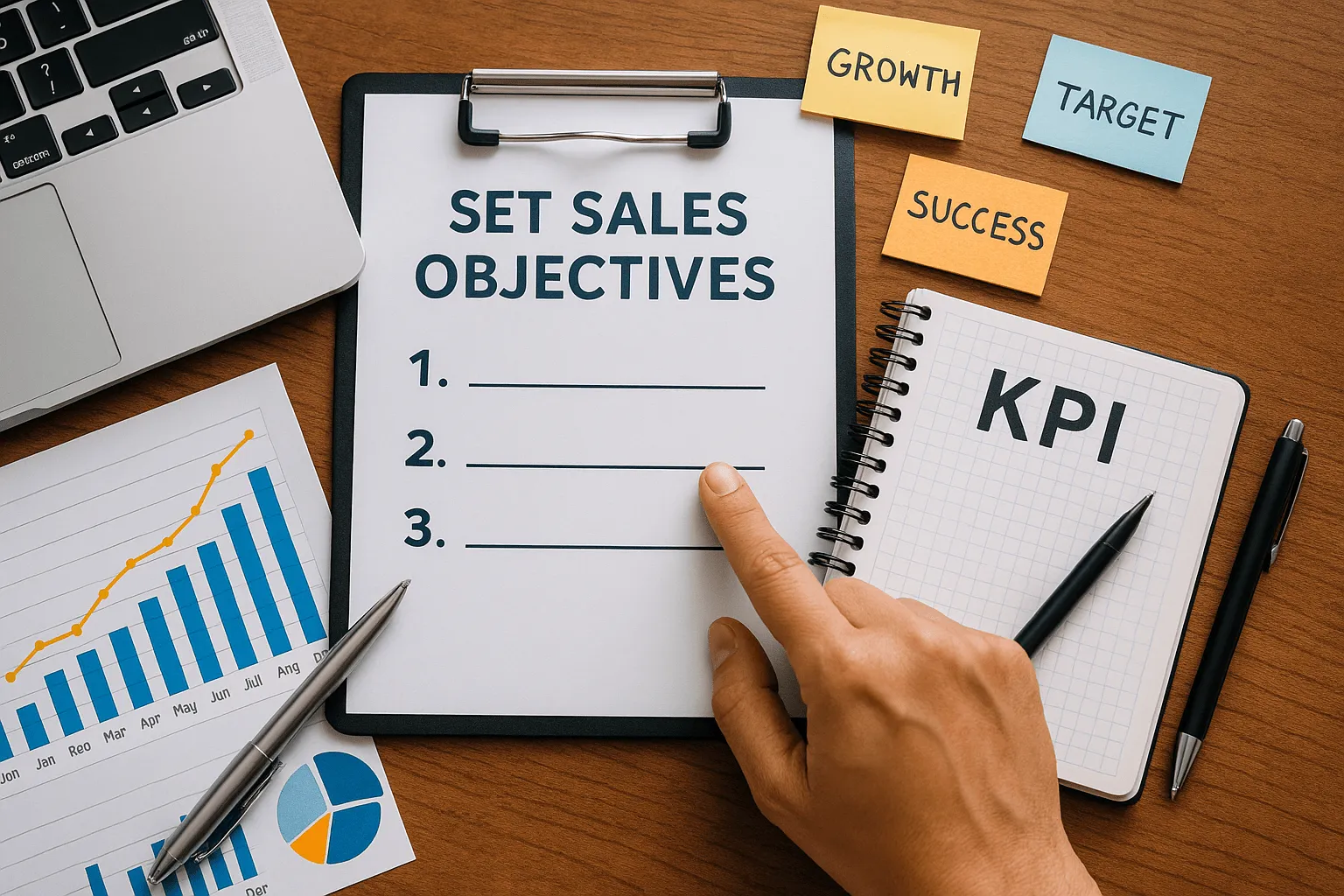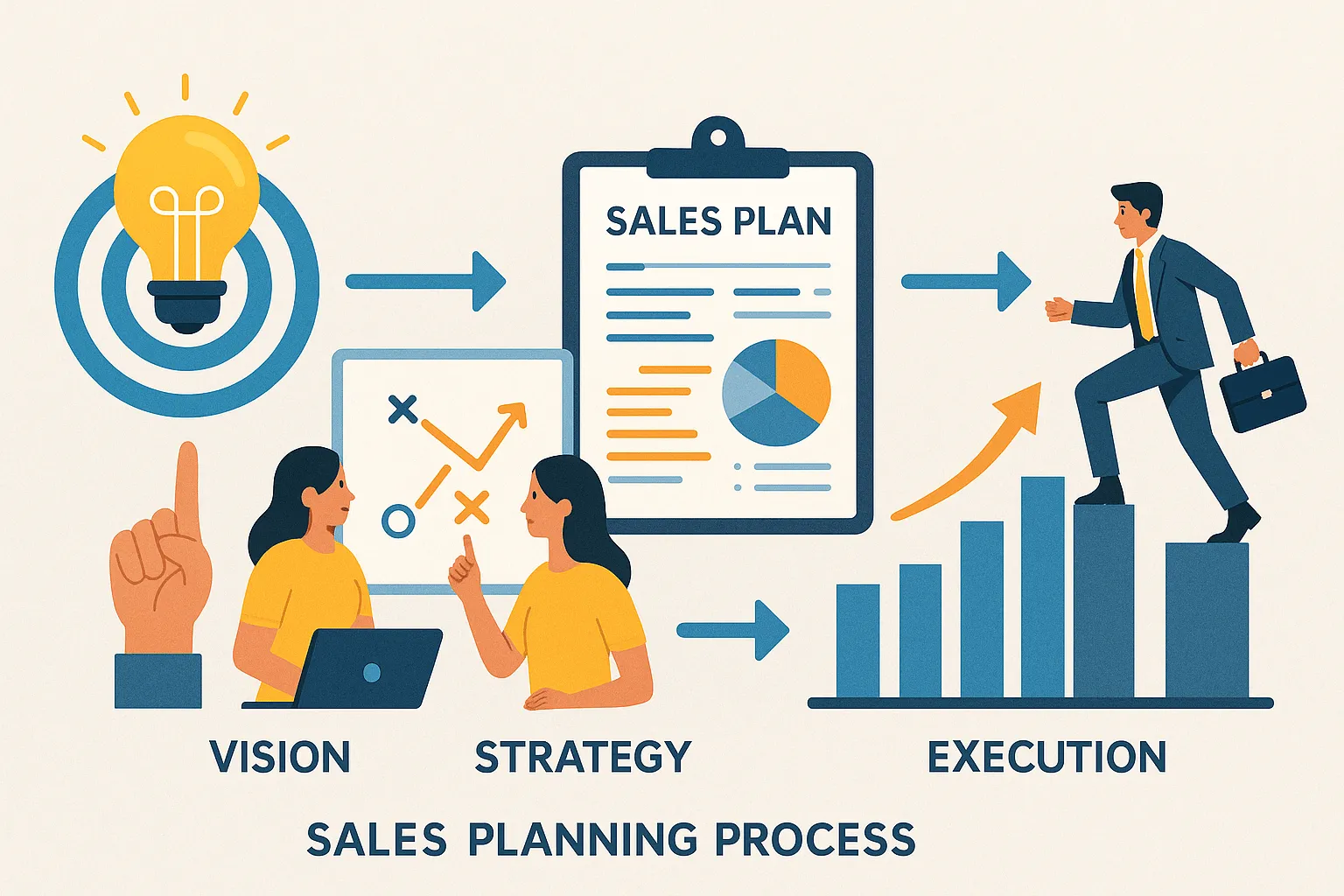Creating a sales plan doesn’t have to be complicated or time-consuming. In fact, if you’ve got 30 minutes and a solid template, you’re halfway there. Effective sales plans give your team a clear roadmap to hit revenue goals faster and with less guesswork.
According to HubSpot, companies with a documented sales strategy see 33% more revenue than those without one, making it easier to calculate customer acquisition cost. So if your team is still winging it with spreadsheets and Slack messages, it might be time for an upgrade.
In this guide, you’ll get a real example of a sales plan from fast-growing businesses, a free template you can copy, and a breakdown of how to build your own plan—quickly.
Whether you’re a startup founder, a sales manager, or just tired of missed quotas, this is built for you. And hey, if you've ever Googled “what should go in a sales plan?”—you’re in the right place.
Ready to stop guessing and start closing? Let’s get into it.
What is a Sales Plan and Why Do You Need One?

A sales plan is a simple roadmap. It helps your sales team know who to sell to, what to say, and how to hit your revenue goals. It tells you where you're going and how to get there—step by step.
Think of it like this: Without a sales plan, your reps may waste time chasing the wrong target market or missing real sales opportunities. With a plan, they focus better and close faster.
According to Harvard Business Review, companies with strong sales planning processes grow 20% faster than those without.
Here’s why you need one:
- It sets clear sales goals and sales targets for your entire team.
- It defines your target customers and ideal sales process.
- It connects with your marketing strategy so everyone works together.
- It improves sales performance by tracking real performance metrics.
If you need help, check out the real example of sales plan below—it’s easy to follow and built for speed. Looking at real strategic sales plan examples can help you model what works and avoid starting from scratch.
“A clear plan is better than a perfect guess.” — Anonymous Sales Leader
Real Example of Sales Plan from a Fast-Growing Business

Example 1: SaaS Startup - B2B CRM Tool
- Business Name: GrowCRM
- Industry: SaaS (Customer Relationship Management)
- Stage: Series A funded startup
- Target Market: Mid-sized B2B companies in North America
- Sales Cycle: 4–6 weeks
Sales Plan Snapshot
Example 2: DTC E-commerce Brand - Organic Skincare
- Business Name: BareGlow Naturals
- Industry: DTC Ecommerce
- Stage: Bootstrapped but fast-growing
- Target Market: Gen Z and millennial women in India and SEA
Sales Plan Snapshot
Example 3: EdTech Platform – Online Certification Courses
- Business Name: SkillLaunch
- Industry: EdTech
- Stage: Seed-funded, high-growth in India and SEA
- Target Market: College grads, young professionals aged 21–30
- Sales Cycle: 2–3 weeks (course decision window)
Sales Plan Snapshot
Example 4: B2B Consulting Firm – Digital Transformation Services
- Business Name: OpsMind Consulting
- Industry: B2B Services (Consulting)
- Stage: 5 years in business, 40% YoY growth
- Target Market: Mid-market companies ($10M–$100M revenue)
- Sales Cycle: 2–4 months
Sales Plan Snapshot
How to Create a Sales Plan That Works — Even If You’re Starting from Scratch
Step-by-Step: Build Your Strategic Sales Plan in Just 30 Minutes

Step 1: Define Your Revenue Targets & Goals
Before you sell anything, you need to know your revenue targets. These are the numbers you want to hit—monthly, quarterly, or yearly.
A sales plan should begin with realistic sales goals. Without them, your sales team won’t know what success looks like.
According to Salesforce, high-performing sales teams are 1.5x more likely to base their goals on clear performance data.
How to implement:
- Start with your current numbers. How much are you selling right now?
- Set SMART goals: Specific, Measurable, Achievable, Relevant, and Time-bound.
- Break those goals into smaller tasks for each sales rep or entire team.
- Think about product pricing, customer count, and sales cycle length.
- Use sales forecasting tools to help predict what’s possible.
Example: Let’s say you want to earn $500,000 this quarter. If your average deal is $5,000, that means you need 100 closed deals. Simple math. But now you have a target.
Pro Tip: Add a small buffer (10–15%) to account for delays or cancellations.
Step 2: Know Your Target Market & Audience
Not everyone will buy from you—and that’s okay. Your job is to focus on people who are most likely to say “yes.” That group is your target market and target audience.
If your team sells to everyone, they’ll waste time and miss real buyers. Segmenting your audience into clear customer segments helps tailor your pitch and boost conversions.
How to implement:
- Look at your current customers. What industries are they in? How big are their companies?
- Identify common pain points. What problems do they need help solving?
- Build clear buyer profiles (also called personas).
- Align with your marketing teams to keep messaging consistent.
- Focus on high-converting channels like LinkedIn, email, or referrals.
Example: If you sell software to HR teams, don’t spend time chasing leads in manufacturing. Your sales reps need to know where the best-fit buyers live.
Step 3: Map Out Your Sales Process
A sales process is a simple guide that tells your sales team what to do at each step—from finding leads to closing the deal. It keeps everyone on track and helps your sales reps work smarter.
If your team doesn’t follow a clear process, they’ll waste time. You’ll miss out on new customers, and your sales goals won’t be met.
How to implement:
- Start with lead generation. Where do your leads come from? (Ads, referrals, LinkedIn?)
- Define each stage clearly. Common stages:
- Prospecting
- Qualifying
- Meeting or demo
- Proposal
- Closing
- Assign responsibilities. Make sure each sales rep knows what part they own.
- Use tools. A good CRM or sales planning software makes this easier. An inbound sales strategy brings qualified leads to you through helpful content and trust-building interactions.
- Teams that follow effective sales strategies close more deals and waste less time chasing the wrong leads.
- Track progress. Your process isn’t final. Keep updating it based on what’s working.
Example: A B2B company might use email to connect with their target market, then offer a product demo, and follow up with a proposal. If they close the deal, the cycle is complete.
Step 4: Set Clear Sales Objectives and KPIs

Sales objectives are short-term goals. KPIs (Key Performance Indicators) are numbers that help you measure progress. Without these, you’re flying blind.
Sales managers and reps need clear goals to stay focused and hit their revenue targets. Salesforce found that 74% of high-performing sales teams use KPIs to guide daily decisions.
How to implement:
- Set weekly and monthly targets. This could be the number of calls, meetings, or deals closed.
- Use KPIs like:
- Win rate
- Deal size
- Time in each sales cycle stage
- Number of qualified leads
- Track with software. Use tools like Salesforce, HubSpot, or Notion to monitor real-time numbers.
- Connect goals to real outcomes. If your entire team hits their KPI, you’re likely to reach your revenue goals too.
Example: If your goal is $100,000 in sales this month and each deal is worth $5,000, then your team needs to close 20 deals.
Step 5: Craft a Sales Messaging Strategy
Sales messaging is what you say to target customers to grab their attention and solve their pain points. It must match what your product offers and what the customer truly needs.
Your message should feel personal, not pushy. Good messaging leads to better sales conversations, higher engagement, and improved sales performance.
How to implement:
- Start by asking: What problem are we solving for the customer?
- Use clear, honest words—avoid jargon.
- Keep the tone friendly and helpful.
- Match messaging across your sales team and marketing campaigns.
- Train your sales reps to handle objections using stories, facts, or use cases.
- Test different versions to see what converts better.
Step 6: Finalize Your Sales Tools & Enablement
Your team needs the right tools to work fast and stay focused. This includes CRMs, email tools, templates, and access to real-time data. Sales enablement tools help your reps stay organized and consistent. They also help sales managers track success.
How to implement:
- Choose tools that support your full sales process.
- Examples include:
- CRM: HubSpot or Salesforce
- Call tools: Gong or Dialpad
- Docs: PandaDoc or Notion
- Make sure the tools help track performance metrics and revenue targets.
- Offer quick training so the entire team knows how to use them.
- Set clear rules: what to update, when to follow up, and how to report progress.
“Salespeople don’t fail because of effort. They fail because of lack of enablement.” – Brent Adamson, Gartner
Empower Sales Professionals to Take Ownership of the Plan
Your sales professionals aren’t just executors—they’re key players. When they help build the plan, they care more about reaching the goals.
- Involve them early when setting sales goals and KPIs.
- Ask what’s working and what’s slowing them down.
- Use that input to improve the sales planning process.
- Celebrate small wins. It builds confidence and morale.
- Give freedom to test new sales tactics while staying aligned with the core sales strategy.
When your team feels heard, they act like owners—not just employees.
Step 7: Forecast and Optimize for Future Growth
Forecasting helps you guess how much you’ll sell in the future. It’s not guessing wildly—it’s based on your current numbers, revenue goals, and the sales cycle. This step helps you plan ahead and avoid surprises.
Start by looking at what worked before. Then use that data to make smart predictions for the next month, quarter, or year.
Here’s how to do it in a simple way:
- Use a sales forecasting tool (like HubSpot, Zoho, or Pipedrive). These tools track your pipeline and give real-time updates.
- Set clear revenue targets for your team. Break them into small goals.
- Track performance metrics weekly—like number of new leads, deals closed, or meetings booked.
- Look for future growth areas like a new market or product line.
- Involve your entire team. When sales reps help set targets, they own the plan.
Pro Tip: Add forecasting to your sales planning process from the start. It helps you create a sales plan that’s not only strong now, but also ready for what’s next.
Sales Planning Process: From Vision to Execution

1. Start with a Clear Sales Vision
Your sales vision explains where your sales team is going and why. It guides every decision you make.
How to implement:
- Ask yourself: What do we want to achieve this year?
- Keep it short, realistic, and tied to your company’s business plan.
- Involve your sales managers and entire team while defining the vision.
Example: “Grow revenue by 25% by entering a new market and acquiring 500 new customers in Q3.”
2. Align Sales Goals with Company Strategy
Your sales goals must support your big-picture marketing strategy and revenue targets.
How to implement:
- Break down annual goals into quarterly, monthly, or weekly goals.
- Align with the product roadmap, sales forecasting, and marketing campaigns.
- Track goals using performance metrics and CRM dashboards.
Use tools: Try sales planning software like HubSpot or Zoho to set, monitor, and adjust goals.
Tip: If your goal is to increase sales by 20%, make sure your sales reps know exactly how many leads or deals they need to close.
3. Define Your Target Market and Buyer Profiles
Know exactly who you're selling to. This includes your target market, target customers, and target audience.
How to implement:
- Collect customer data using Google Analytics or sales CRM.
- Identify pain points from customer feedback and past interactions.
- Build 2–3 detailed buyer profiles based on job role, industry, and needs.
Tip: Use this data to fine-tune your sales messaging, sales tactics, and even pricing.
4. Map Out the Sales Process & Tactics

You can't win without a clear game plan. Your sales process is that plan. It’s the step-by-step path your sales reps follow to move a target customer from interest to close. And sales tactics are the actions they take at each step.
A good example of sales plan always outlines:
- Who does what in the sales team
- What to say in sales conversations
- When to follow up (and how often)
Tip: Use tried-and-tested frameworks. For example, the AIDA model (Attention, Interest, Desire, Action) works well for many sales organizations.
5. Choose the Right Tools and Sales Forecasting Models
To grow, you need to plan ahead. That’s where sales forecasting helps. It tells you how much revenue you might make in the future. But you’ll need the right sales tools and performance metrics to get there.
Use tools like:
- CRM software for tracking customer data and deals
- Sales planning software like HubSpot or Clari
- Dashboards to monitor sales performance and revenue targets
Match your forecast with your business plan and sales goals. It keeps you realistic and ready.
“The best forecasts come from combining real-time data with insights from your sales leaders,” says Salesforce’s annual State of Sales report.
6. Collaborate Across Teams for Execution
A plan is just paper without action. That’s why your sales and marketing teams must work together. This means:
- Marketing teams share pain points and audience data.
- Sales uses that data to personalize outreach.
- Together, they align around revenue goals.
Collaboration tip: Set shared OKRs (Objectives and Key Results) between departments.
Even your customer success and support teams help. They close feedback loops and retain existing customers—a big part of any successful sales plan.
7. Review, Optimize, and Repeat
Reviewing means checking your sales performance. Optimization means fixing what’s not working. Repeat means doing this often.
How to Implement:
- Look at performance metrics: Are you meeting your sales goals and revenue targets?
- Talk to your sales reps: Ask them what’s working in real sales conversations.
- Track customer feedback: Use it to improve your pitch.
- Adjust sales tactics: Swap what's outdated for tools that increase sales.
- Test new strategies: “Companies that test and optimize regularly see 30% more revenue growth,” says McKinsey.
Quick Tips:
- Use sales planning software to monitor results in real time.
- Share insights with your sales and marketing teams.
- Set time each month to review the full sales planning process.
Pro Tip: A successful sales plan is never “done.” It’s a living process you keep improving. That's how you stay ahead.
Why Your Sales Plan Must Align with Your Marketing Strategy

If your sales team is chasing one goal while your marketing teams are focused on something else, your entire strategy falls apart.
A smart sales strategy only works when it's built alongside a clear marketing strategy. Both should speak to the same target audience, address the same pain points, and drive the same revenue goals.
Let’s look at a simple example of sales plan done right:
A SaaS company sells to small businesses. The sales reps know their target customers are budget-conscious. Marketing runs email campaigns that highlight value for money. This way, the messaging stays consistent.
Here’s how to align both teams:
- Define shared sales goals and performance metrics
- Create content together to support the full sales process
- Use customer feedback to guide campaigns and pitches
- Review efforts monthly using tools like CRM or sales planning software
How to Use Sales Strategy to Guide Daily Actions

1. Break Down the Sales Strategy Plan into Daily Micro-Goals
A big sales strategy plan can feel overwhelming. That’s why you need to break it into small, clear goals.
- Start by looking at your revenue targets and sales goals.
- Ask: “What do I need to do today to move one step closer?”
- Set daily actions like sending 10 follow-ups or qualifying 5 new target customers.
- Use sales planning software to assign and track tasks.
“Micro-goals lead to macro-results.” That’s a rule top sales managers live by.
2. Assign Specific Tasks to Each Stage of the Sales Funnel
Each part of the sales funnel needs different actions. Your sales reps should know what to do at each step.
- Top of funnel: Focus on lead generation and identifying your target market.
- Middle of funnel: Book meetings, hold strong sales conversations, and identify pain points.
- Bottom of funnel: Send proposals, handle objections, and push for close.
This helps the entire team avoid confusion and boosts sales performance. Clear tasks = faster wins.
3. Align Sales and Marketing Teams for Unified Messaging

If your sales and marketing teams don’t talk, your message gets lost. That’s a problem.
- Meet weekly to review campaigns, marketing strategy, and target audience.
- Share data from customer feedback and sales process results.
- Make sure your sales messaging matches the ads and emails marketing sends out.
According to HubSpot, businesses that align sales and marketing see 36% more revenue growth.
4. Choose Daily Sales Tactics That Reflect Long-Term Strategy
You need to pick smart actions that match your big goals. Let’s say your sales strategy plan is to grow in a new market. Then your daily task could be to contact 5 new leads or test a new sales messaging style. That way, you’re moving in the right direction—bit by bit.
Try this:
- Match your daily sales calls to the target market you want to reach
- Use short checklists for daily actions (like follow-ups or email pitches)
- Focus on solving customer pain points, not just making a pitch
“Tactics without strategy is the noise before defeat.” – Sun Tzu. In sales, they must work together.
5. Track Daily Metrics to Spot What’s Working (and What’s Not)
You can’t fix what you don’t measure. Use performance metrics to check if your daily tasks are working.
Look at:
- How many emails got replies?
- How many calls turned into meetings?
- Which sales reps are closing the most?
Tools like sales planning software or sales enablement tools help track these numbers fast. They also make it easy to spot winning moves.
Use dashboards to track:
- Daily sales performance
- Leads added to your sales funnel
- Progress toward weekly revenue goals
6. Adjust in Real Time Based on Trends and Feedback
Things change. So should your plan. If your emails aren’t working, tweak your subject line. If a certain pitch flops, try new words that match what your target customers care about. Daily feedback from existing customers and your sales representatives can guide smart updates.
Here’s how to adjust quickly:
- Use customer feedback from calls and demos
- Watch for industry trends or shifts in buyer behavior
- Let marketing teams and sales and marketing teams share updates fast
By taking small steps daily—and tracking them—you make sure your sales plan doesn’t just look good. It works.
How to Tailor Your Sales Plan for Different Audiences

1. Start by Segmenting Your Target Audience Clearly
Not all target customers are alike. Your sales team must split the audience into groups based on their needs, location, budget, or business type. This is called audience segmentation.
A one-size-fits-all sales strategy often fails because different people have different problems.
How to implement:
- Use customer data from past deals.
- Look at performance metrics like response rates or purchase behavior.
- Group your audience by size, industry, or buying power.
2. Understand the Unique Pain Points of Each Segment
Each segment has its own struggles or "pain points". One group may need faster service. Another may want a lower price.
How to implement:
- Talk to your sales reps about feedback they hear in sales conversations.
- Review customer feedback and FAQs.
- Track trends using sales planning software.
Example: If you're selling software, startups might care about price while enterprises worry about security.
By knowing this, you can craft better offers—and earn trust faster.
3. Customize Value Propositions for Each Buyer Type

Once you understand the pain points, rewrite your pitch. Your sales messaging should show exactly how your product helps that segment.
How to implement:
- Use case studies that match the buyer type.
- Adjust marketing campaigns based on segment needs.
- Train your sales team to adapt their pitch per segment.
Example of sales plan in action: If you're targeting a healthcare firm, your sales strategy plan should include compliance benefits. If it's retail, highlight speed and ease of use.
4. Adjust the Sales Cycle Length and Approach
Not every customer buys the same way. Some take weeks. Others decide in a day.
What to do:
- Look at your sales cycle. Is it too long or too short for a specific buyer group?
- For B2B clients, you may need more steps. For consumers, keep it fast and easy.
- Change your sales approach. Some buyers like calls, others prefer email or chat.
Pro Tip: Shorten the cycle for repeat or existing customers to boost revenue faster.
Shortening the cycle where possible helps your sales reps close faster and hit sales targets more often.
5. Involve the Right Stakeholders at the Right Time
Your sales team is not alone. You need help from others.
Who to involve and when:
- Sales managers should review deals early to set the right goals.
- Include marketing teams for better sales messaging.
- Bring in customer support if the buyer asks about onboarding.
The entire team working together means fewer mistakes and better support for the buyer.
6. Use Data to Continuously Improve Personalization
Don’t guess what’s working. Use customer data and feedback.
How to do it:
- Track performance metrics like response time, deal close rate, and feedback scores.
- Use tools like sales planning software to spot what’s working and what’s not.
- Apply findings to tweak offers for each target market.
Your sales strategy becomes smarter. It helps you personalize at scale and increase sales steadily.
How Customer Relationship Management Systems Improve Sales Execution and Forecasting

Customer Relationship Management (CRM) systems help sales teams work smarter. They store customer data, track deals, and show what’s working. If you’re building an example of sales plan, a good CRM makes it easier to set clear goals and hit revenue targets.
Here’s how CRMs help:
- Organize customer relationships in one place
- Show the full sales cycle from lead to close
- Help sales reps follow up on time
- Track sales performance and deal progress
- Use real data for sales forecasting
CRMs also help sales managers see which reps need coaching. You can spot slow deals and fix bottlenecks early. And with better customer feedback, teams can adjust their approach to match what buyers really want.
Tools and Tips to Increase Sales and Track Progress

1. CRM Tools – Centralize Customer Data and Sales Activity
CRM stands for Customer Relationship Management. It’s software that stores all your customer details, emails, calls, and follow-ups in one place. It’s like a digital notebook that helps you never miss a deal.
Top Tools:
- HubSpot CRM: Free to start, user-friendly, perfect for small and growing teams.
- Salesforce: Great for large sales organizations that want detailed reports.
- Zoho CRM: Budget-friendly with features like sales forecasting and email tracking.
CRM tools show you your entire sales pipeline—from first contact to closed deal. You can track your team’s daily tasks and check what’s working.
It’s also great for customer relationship management, which improves your chances of keeping existing customers.
Tip: Use these tools to track customer interactions, monitor deals in the pipeline, and improve customer relationship management.
2. Sales Planning Software – Build and Monitor Strategic Plans
These tools help you build your strategic sales plan and stay on track. You can set your revenue targets, assign tasks, and track real-time results.
Top Tools:
- Monday Sales CRM: Simple and visual for tracking team activity.
- Trello + Google Sheets: Best for teams who want flexibility and control.
- Clari: Ideal for fast-growing companies needing strong sales forecasting and performance metrics.
You don’t want to be guessing mid-quarter. These tools help you plan clearly and measure actual results.
Tip: Set quarterly sales goals and track them against real-time KPIs to avoid mid-quarter surprises.
3. Lead Generation Tools – Fill Your Pipeline Consistently

Want more new customers? You need lead generation tools. These tools help you find people who are likely to buy from you. They also collect useful customer data like email, job title, and company size.
Top Tools:
- Apollo.io: Sends cold emails and finds verified contact info.
- LinkedIn Sales Navigator: Great for sales reps who sell B2B.
- Clearbit:
These tools help sales professionals find the right people faster and reduce wasted time. You can also test subject lines and sales messaging to see what works.
Tip: Run A/B tests on subject lines and CTAs to improve reply rates.
4. Revenue Intelligence & Forecasting Tools – Stay Ahead of Trends
You can't hit revenue targets if you don’t know what’s coming. That’s where sales forecasting and revenue intelligence tools help. They track your team’s calls, deals, and show you what’s working—and what’s not.
Top Tools:
- Gong: Records and reviews real sales conversations to spot trends.
- InsightSquared: Shows deep performance metrics in dashboards.
- Revenue.io: Suggests actions in real time to boost sales performance.
These tools let sales leaders and sales managers make smart decisions. You’ll spot slow deals early and adjust your plan to meet your revenue goals.
Tip: Use sales forecasting to identify bottlenecks and predict sales trends across teams and products.
5. Collaboration & Sales Enablement Platforms – Empower the Entire Team
Selling is not a one-person job. Your entire team must work together. That means sales and marketing teams need to stay in sync. These tools help you share updates, fix problems fast, and keep your sales messaging on point.
Top Tools:
- Slack + Salesforce Integration: Brings chats and CRM updates into one place.
- Notion: Tracks deals, tasks, and meeting notes in a single dashboard.
- Seismic: A leading sales enablement tool for sharing playbooks and content.
When your team shares info, everyone wins. You avoid confusion, move faster, and respond to customer feedback quickly.
Tip: Keep your sales and marketing teams aligned on messaging, goals, and customer feedback to close faster.
6. Measure and Improve Sales Performance Across the Team
You can't fix what you don't track. Measuring sales performance shows what’s working and what’s not. You’ll spot patterns, coach better, and close more deals.
Top Tools:
- Gong: Analyzes real calls to show what top sales reps say.
- Ambition: Helps sales managers track daily goals and team contests.
- Tableau or Power BI: Visual dashboards to track KPIs like win rate, revenue, and deal time.
Key metrics to watch:
- Win rate – How many deals you close
- AOV – Average order value
- Time-to-close – How fast deals move
Tip: Review team metrics weekly—like win rate, AOV, and time-to-close—to spot what's working. Use these insights to coach, reward, and improve sales performance over time.
Sales Plan FAQs: Common Mistakes and Expert Answers

1. What to avoid when writing your sales business plan?
- A common mistake is being too broad. Don’t forget your target market. Be clear about your sales goals, pain points, and how your sales reps should act on them.
- Also, avoid copying a generic example of sales plan. Customize it for your sales team, industry, and marketing strategy. A one-size-fits-all model won’t help you increase revenue or hit your revenue targets.
2. How often to update your sales plan template?
- Update it every quarter or after a major change—like launching a new market or changing sales tactics.
- Use your performance metrics—like win rate, time-to-close, and sales cycle data—to guide these updates. Teams using live data from tools like Tableau or Gong improve sales performance by up to 28%, according to Harvard Business Review.
3. How do you write a selling plan?
- Start with your target customers. Then define your product’s value, pricing, and sales process. Set clear revenue goals. Plan your sales initiatives, and list the sales enablement tools your sales reps will need.
- Use a good sales plan template to stay organized. And yes, your marketing departments should help shape the sales messaging.
4. When to involve marketing departments and sales leaders?
- Early. Your sales and marketing teams must work together on the message, customer feedback, and lead scoring.
- Involve your sales leaders in reviews and updates, so goals stay clear for the entire team.
5. What is the 30-60-90 rule in sales?
It’s a simple sales strategy plan.
- First 30 days: Learn the product and customer relationships.
- Next 30: Start selling and building your sales pipeline.
- Last 30: Improve pitch, hit your sales targets, and aim for sales success.
Social media marketing can help bring in new customers and grow brand awareness fast. It’s smart to involve your marketing departments early if you plan to use it as part of your sales strategy.
Final Note
A strong sales plan is your guide to reach your goals. Use every example of sales plan to learn what works best. Don’t skip the basics like creating a sales plan that fits your target audience and sales department. Keep your business plan updated and track results often. And yes—review your strategic sales plan when launching new sales initiatives. That’s how sales forecasting improves. As experts say, “A well-crafted plan doesn’t just track progress—it drives it.”








